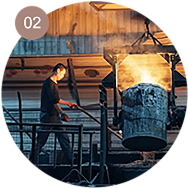
what are dutch ovens made out of
What Are Dutch Ovens Made Out Of?
Dutch ovens are beloved kitchen tools that have been used for generations. Renowned for their ability to retain heat and distribute it evenly, these heavy cooking pots are ideal for a wide variety of cooking methods, including braising, baking, stewing, and frying. However, one key to their effectiveness lies in the materials from which they are made. This article will explore the different materials used to make Dutch ovens and the benefits each brings to the cooking experience.
Cast Iron
The most traditional and popular material for Dutch ovens is cast iron. Known for its exceptional heat retention and even heat distribution, cast iron Dutch ovens are perfect for slow cooking and simmering. The porous nature of cast iron allows it to develop a natural non-stick surface when properly seasoned, enhancing the flavors of dishes over time.
One of the major advantages of cast iron is that it can withstand high temperatures, making it suitable for use on the stovetop as well as in the oven. Additionally, cast iron Dutch ovens can be used over an open flame, making them great options for camping and outdoor cooking.
However, cast iron does require some maintenance. It is important to season the pot regularly to prevent rust and maintain its non-stick properties. This involves applying a thin layer of vegetable oil and baking it to create a protective layer. Despite this upkeep, many chefs and home cooks swear by their cast iron Dutch ovens, often passing them down through generations.
Enameled Cast Iron
Enameled cast iron Dutch ovens are another popular choice. These are made from cast iron that has been coated with a layer of enamel, which is typically ceramic-based. This coating provides a smooth, non-reactive surface that does not require seasoning, making it easier to clean and maintain.
The enamel coating comes in a variety of colors and finishes, allowing users to select a Dutch oven that suits their kitchen aesthetics. Enameled cast iron is also less prone to rust and can be used to cook acidic dishes, such as tomato-based recipes, without fear of reacting with the iron.
what are dutch ovens made out of

However, enameled cast iron is typically more expensive than regular cast iron due to the additional manufacturing process. While the enamel does increase the versatility and ease of use, users should take care to avoid scratching or chipping the surface, as this can compromise its performance.
Aluminum
Less traditional but gaining popularity, aluminum Dutch ovens are lightweight and often come with a non-stick coating. While aluminum is a good conductor of heat, it does not offer the same heat retention as cast iron. Therefore, aluminum Dutch ovens may not be ideal for slow cooking but can be suitable for quick meals or certain baking applications.
An advantage of aluminum is its affordability and ease of handling compared to heavier cast iron options. However, it is important to note that aluminum can react with acidic foods, leading some cooks to prefer non-reactive materials for certain recipes.
Stainless Steel
Finally, stainless steel Dutch ovens are also available, appealing to those looking for a modern option. Stainless steel is known for its durability and resistance to rust, staining, and corrosion. These pots are usually equipped with a heavy bottom for improved heat distribution.
While stainless steel Dutch ovens can handle high temperatures and are often dishwasher safe, they do not retain heat as effectively as cast iron, which may impact cooking times and methods. Nevertheless, many find stainless steel a convenient option for everyday use due to its maintenance-free nature.
Conclusion
The material of a Dutch oven significantly influences its performance and maintenance. Whether you opt for the traditional cast iron, the colorful enameled version, the lightweight aluminum, or the contemporary stainless steel, each material has its strengths and considerations. Ultimately, the best choice depends on your cooking style, aesthetics, and willingness to perform maintenance. Regardless of the material, a quality Dutch oven can enhance your cooking experience, making it a worthwhile investment in your kitchen.
-
High Quality Cast Iron Pancake Crepe Pan - ZD Cookware | Durable, Non-Stick, Wooden HandleNewsJul.13,2025
-
High Quality Cast Iron Cookware - ZD Cookware|Durable Heat Retention&Non-Stick SurfaceNewsJul.13,2025
-
Cast Iron Pancake Crepe Pan-Durable Kitchenware-ZD CookwareNewsJul.13,2025
-
Premium Cast Iron Cookware ZD Cookware|Durable Non-Stick Wooden HandleNewsJul.13,2025
-
Durable Cast Iron Pancake Crepe Pan - Zhejiang ZD Cookware Co., Ltd.|Heat Retention,Durability,Non-Stick Surface,Versatile Cooking,Wooden HandleNewsJul.12,2025
-
High Quality Cast Iron Cookware - ZD Cookware | Black Pancake Pan, Non-Stick SurfaceNewsJul.12,2025


